You can help expand this article with text translated from the corresponding article in French. (April 2021)Click [show] for important translation instructions.
|

This is a survey of the postage stamps and postal history of France.
You can help expand this article with text translated from the corresponding article in French. (April 2021)Click [show] for important translation instructions.
|

This is a survey of the postage stamps and postal history of France.
The first stamps of France were issued on 1 January 1849. [1] They were designed by Jacques-Jean Barre. The medallion depicts the head of goddess Ceres facing left.
In 1852 a new series of definitive stamps were issued, retaining the inscription "REPUB FRANC" but replacing Ceres with the head of Louis-Napoléon Bonaparte.
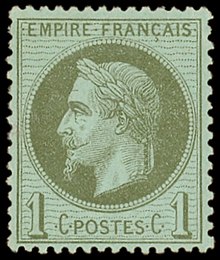
In 1853, after proclamation of the 2nd Empire, the inscription was changed to "EMPIRE FRANC", while retaining the head of Napoleon III in the medallion.
Starting in 1862, a new type of definitive stamp was introduced. It depicts the head of Napoleon III with a laurel wreath and the inscription changed to "EMPIRE-FRANÇAIS".
The Napoleon stamps remained in use until the fall of the 2nd Empire in 1870.
The Ceres series stamps, in a slightly different design and printed in lithography, were reintroduced in 1870 and remained in use until 1876. In 1876 a new design of definitive stamps was introduced. It was designed by Jules Auguste Sage and displayed an allegory of Commerce and Peace.

The postal and philatelic history of Canada concerns postage of the territories which have formed Canada. Before Canadian confederation, the colonies of British Columbia and Vancouver Island, Prince Edward Island, Nova Scotia, New Brunswick and Newfoundland issued stamps in their own names. The postal history falls into four major periods: French control (1604–1763), British control (1763–1841), colonial government control (1841–1867), and Canada, since 1867.

A definitive stamp is a postage stamp that is part of the regular issue of a country's stamps, available for sale by the post office for an extended period of time and designed to serve the everyday postal needs of the country. The term is used in contrast to a "provisional stamp", one that is issued for a temporary period until regular stamps are available, or a "commemorative stamp", a stamp "issued to honor a person or mark a special event" available only for a limited time. Commonly, a definitive issue or series includes stamps in a range of denominations sufficient to cover current postal rates. An "issue" generally means a set that is put on sale all at the same time, while a "series" is spread out over several years, but the terms are not precise. Additional stamps in a series may be produced as needed by changes in postal rates; nevertheless some values may be permanently available, regardless of prevailing rates; examples include 1c or 1p and $1 or £1.
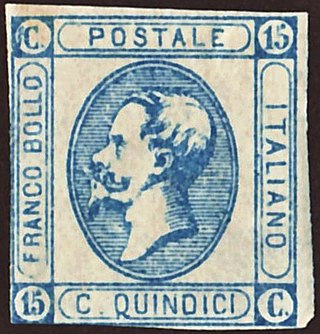
This is an introduction to the postal and philatelic history of Italy.
"French Colonies" is the name used by philatelists to refer to the postage stamps issued by France for use in the parts of the French colonial empire that did not have stamps of their own. These were in use from 1859 to 1906, and from 1943 to 1945.

Gabon is a country in west central Africa sharing borders with the Gulf of Guinea to the west, Equatorial Guinea to the northwest, and Cameroon to the north, with the Republic of the Congo curving around the east and south. Its size is almost 270,000 km² with an estimated population of 1,500,000. The capital and largest city is Libreville.
This is a survey of the postage stamps and postal history of Macau.

This is a survey of the postage stamps and postal history of Romania.
This is a survey of the postage stamps and postal history of Mozambique.

The postal history of Malta began in the early modern period, when pre-adhesive mail was delivered to foreign destinations by privately owned ships for a fee. The earliest known letter from Malta, sent during the rule of the Order of St John, is dated 1532. The first formal postal service on the islands was established by the Order in 1708, with the post office being located at the Casa del Commun Tesoro in Valletta. The first postal markings on mail appeared later on in the 18th century.
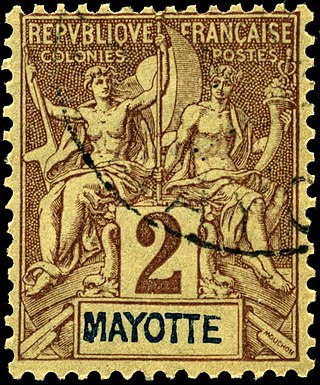
This is an overview of the postage stamps and postal history of the Indian Ocean island of Mayotte, one of the Comoros Archipelago islands located on the south-east side of Africa.
This is a survey of the postage stamps and postal history of Angola.
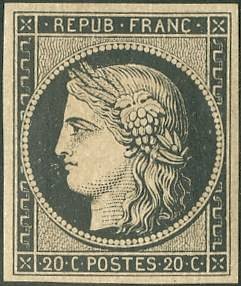
The Ceres series was the first postage stamp series of France, issued in 6 different values from 1849 to 1850 as a representation of the French Republic.
Anatole Auguste Hulot was a French civil servant who directed the designing and printing of the first postage stamps of France between 1848 and 1876.

Mauritius, a small island in the southwest Indian Ocean, is important to the world of philately for a number of reasons. Its first two postage stamps issued in 1847, called the "Post Office" stamps, are of legendary rarity and value. They were the first stamps issued in any part of the British Empire outside of Great Britain. The unique cover bearing both “Post Office” stamps has been called "la pièce de résistance de toute la philatélie" or "the greatest item in all philately". The cover was sold at auction, in Zurich, on 3 November 1993, for 5.75 million Swiss francs, the equivalent of about $4 million – the highest price ever paid for a single philatelic item up to that time. In addition, Mauritius is well known for the subsequent locally produced issues known as "primitives," also prized by collectors.

The postal history of Turkey and its predecessor state, the Ottoman Empire, dates to the 18th century when foreign countries maintained courier services through their consular offices in the Empire. Although delayed in the development of its own postal service, in 1863 the Ottoman Empire became the second independent country in Asia to issue adhesive postage stamps, and in 1875, it became a founding member of the General Postal Union, soon to become the Universal Postal Union. The Ottoman Empire became the Republic of Turkey in 1923, and in the following years, its postal service became more modernized and efficient and its postage stamps expertly designed and manufactured.

Germania stamps are definitive stamps that were issued by the German Empire and the Weimar Republic between 1900 and 1922, depicting Germania. They represent the longest running series in German philately and are in their many variations and derivations an essential part of German philatelic collections.
Canada Post has issued several definitive stamps series since the Dominion of Canada was formed in 1867 featuring both novel and recurring themes. See Postage stamps and postal history of Canada for an overview and for history prior to federation.

This is a survey of the postage stamps and postal history of Fezzan and Ghadames, both now part of Libya.
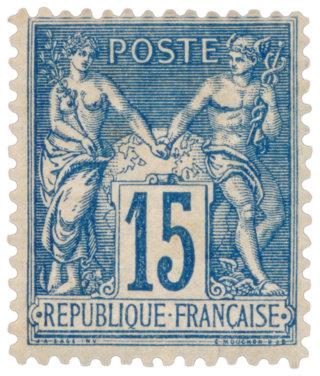
"Type Sage" is a reference to the definitive series of postage stamps issued by the post office of France between 1876 and 1900. Printed in a variety of colors and shades, the two central figures are allegories of Peace (left) and Commerce (right), giving rise to the name of the series. The name "Type Sage" comes from the tendency of French stamp collectors to refer to the series by the name of the designer of the artwork, in this case Jules Auguste Sage, whose name appears as "J. A. SAGE INV" along the lower left edge of the stamp beneath the word "REPUBLIQUE" of "REPUBLIQUE FRANCAISE."

Jules Auguste Sage was a French poet, artist and sculptor. He is known for giving his name to a type of French postage stamp, Type Sage, first issued in 1876.
{{cite web}}: CS1 maint: archived copy as title (link) Retrieved 23 September 2010